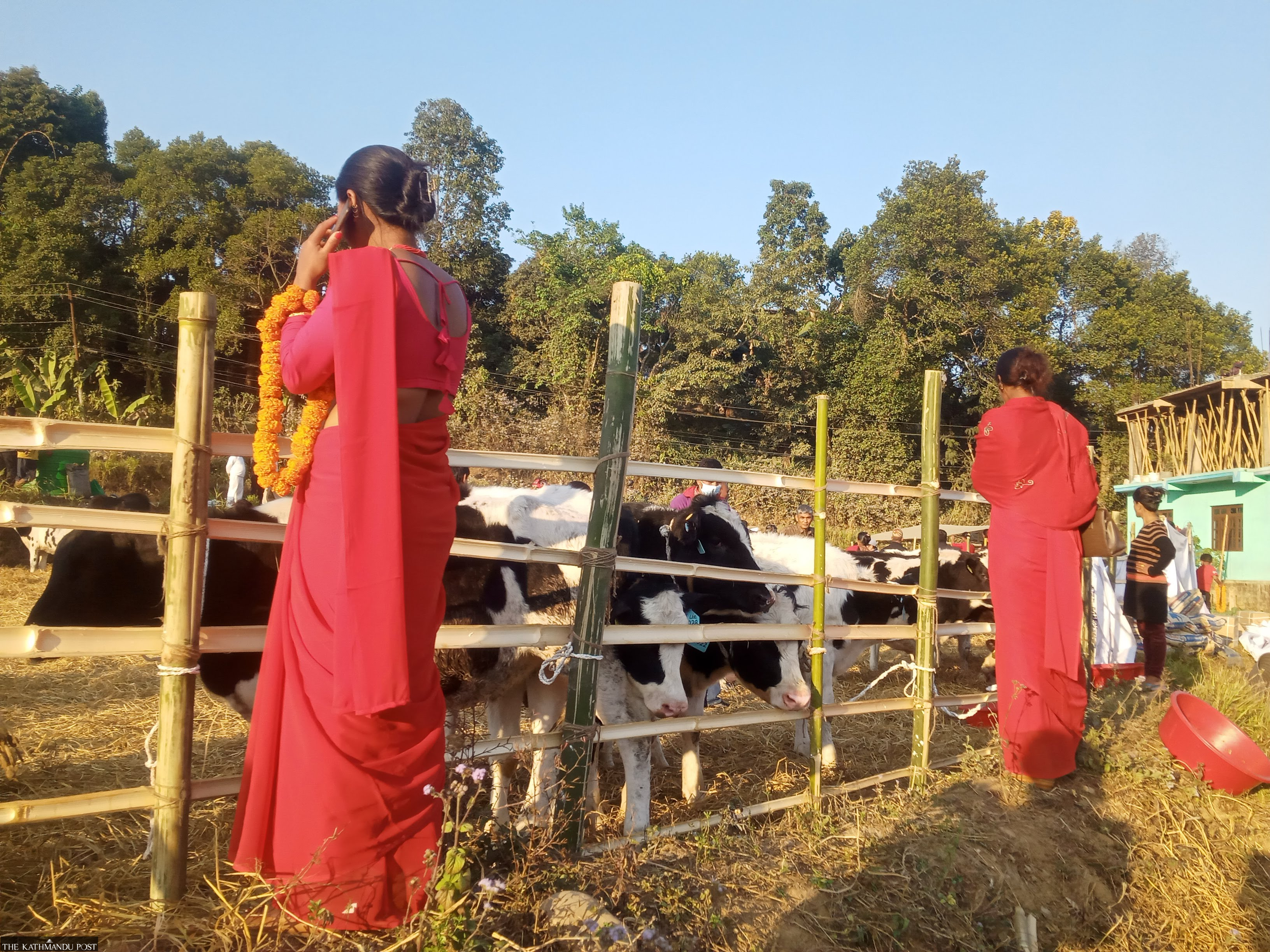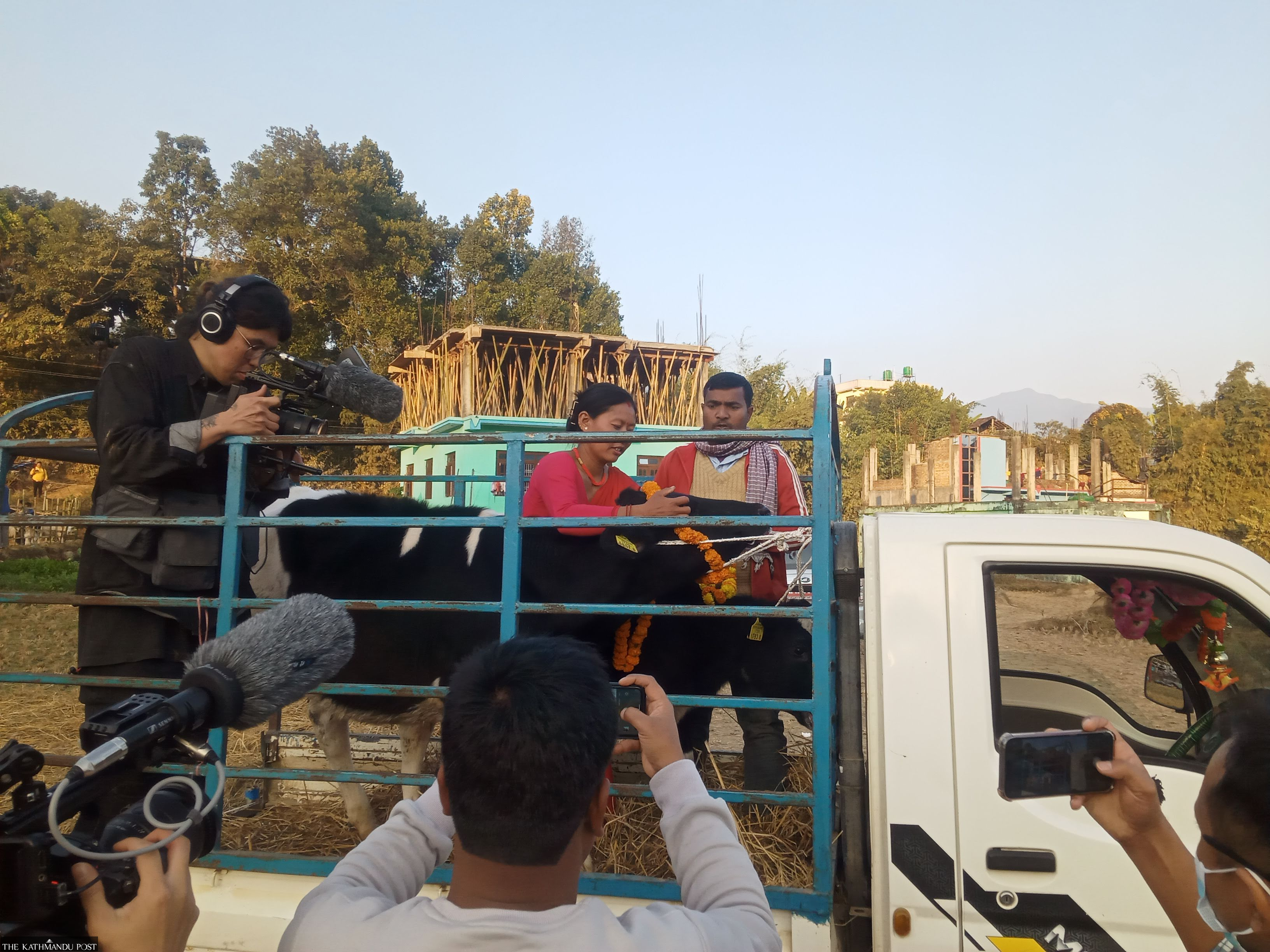Money
With Holstein cows, Sindhuli looks to boost dairy sector
The baby cows are part of a gift from South Korea of 101 Holstein heifers and 20 high genetic-worth breeding bulls.
Sangam Prasain
Last Sunday, Anisha Karki of Rajpani village in Sindhuli was looking for her gift of two heifers from South Korea among the 57 animals in the corral.
She held two flower garlands in her hands, which she planned to put around their necks to welcome them to her home.
The baby cows have yellow numbered tags on their ears, and are part of a gift from South Korea of 101 Holstein heifers and 20 high genetic-worth breeding bulls.
The animals arrived under the Milky Way project, a joint initiative of Nepal and South Korea, to establish a high-quality nucleus herd to modernise the dairy industry. They were airlifted from South Korea, quarantined in Kathmandu and delivered to the farmers in Sindhuli, about 150 km east of the capital.
“My heifers have tag numbers 10 and 13. I haven’t found them yet,” Karki told the technicians. She was also thinking of giving them Nepali names.

Karki and other farmers were wandering around the corral, checking the tags of the baby cows that are about 3 feet tall and have black and white spots.
“Initially, I did not believe they were free of cost. I also did not believe they could give 30 litres of milk a day,” said Karki. “I currently own four cows. They give me 45 litres of milk daily.”
Karki is a member of Mathilo Raj Pani Farmers’ Group, a cooperative which collects milk from farmers and sends it to market. “I get paid Rs67 per litre,” she said.
Karki earns enough to put her children in a private boarding school. “We don’t have other income sources. We have a 10-kattha farm (3,640 square feet) on which we grow some vegetables and cereals.”

The heifers that were brought to Nepal have been donated by South Korean farmers. The Nepali farmers too, after their cows give birth, have to donate the calves to other farmers which is known as “passing the gift”.
The heifers and bulls belong to the Holstein breed. A heifer costs $3,000 and a bull costs $200,000.
“These heifers cannot be sold. When these heifers grow and produce a baby, they have to be passed on as gifts to other farmers,” said Thakur Khadka, Heifer Programme Officer in Sindhuli.
According to dairy farmer Karki, the donor has also given them 50 kg of silage, a type of fodder made from green foliage crops which have been preserved by fermentation and are fed to cattle.
“I have been told to mix the silage with green grass and paddy straw to make perfect fodder,” said Karki who has a family of four. “That’s a perfect gift for me. I can boost my income by selling milk after one and a half years.”

Another dairy farmer Urmila Bhattarai Kari is happy too. She is the chairperson of the women’s group which has 23 members. “Eleven in our group got the heifers. The others will also receive them gradually.”
Some farmers complained that they were told they would get two heifers but got only one.
According to officials at Heifers International Nepal, the plan was to give two heifers per family, but they were short of 20 heifers after the Ministry of Agriculture and Livestock Development asked for 20 heifers for research purposes in addition to the 20 bulls the government had received.
Kari’s migrant worker husband returned from Malaysia two years ago after a stay of five years. They have a 15-kattha farm, and own two buffalos and eight he-goats.
“The income from the farm is not sufficient for our family of seven. I hope that, once the heifers grow and begin to give milk, it could be a great support for me,” she said.
The project selected 50 farmers in Sindhuli and built an improved shed costing Rs150,000.

Kamalamai Municipality of Sindhuli was chosen after a feasibility study which received enthusiastic support from the local government.
A Japan International Cooperation Agency (JICA) report shows that this area has enormous potential for dairy products since it has a moderate climate and receives rainfall in the summer.
The Sindhuli Road Corridor Commercial Agricultural Project was launched by JICA Nepal in 2015. The objective was to ensure benefits to the local residents along the Sindhuli Highway by developing opportunities to improve their livelihoods through the agricultural commercialisation of high-value commodities with the “grow and sell” concept.
The scheme aims to raise income for farmer groups in Kabhrepalanchok, Dolakha, Ramechhap and Sindhuli districts by developing a value chain for vegetable farming and safeguarding economic revitalisation of the less developed area. The sweet orange farm has become a huge success now.
Heifers International officials say that demand for milk in Kathmandu is very high, and Sindhuli can bridge the gap.

Sujan Prasad Bhatta, a junior technical assistant (JTA) serving in the livestock care sector for the last one and a half decades, says the heifers brought from South Korea are healthy and have easily adapted to Nepal’s climate.
“That’s the good part. If this project succeeds, it will transform Sundhuli as a model dairy village within a couple of years.” According to Bhatta, farmers in Nepal rear cows and buffalos, but milk productivity is very low.
“Nepal’s dairy industry can take a great leap forward within the next five years with the quality Holstein cows. Demand for heifers is rising. If these Holstein cows give birth, Nepali farmers should make a 'sister' group and pass on the gift to other farmers,” he said.
“The heifers cannot be sold. The South Korean farmers have given them to Nepali farmers as a gift. The Nepali farmers also have to do the same,” said Bhatta, who was also involved in the Heifers goat programme launched in Nepal in 2012.
Farmers made a good income when they reared Jamunapari and Khari breeds of goats under the heifer's goat project. Jamunapari goats were introduced in Nepal to improve the body weight of the local Khari and Tarai goats.
“The heifer project to increase milk too looks encouraging,” said Bhatta.

A 2020 study estimated that a Nepali consumes 72 litres of milk and dairy products annually, while the recommended requirement is 91 litres.
The Department of Livestock Services estimates that the milk deficit will likely worsen as the production of dairy products is growing at the rate of 4 percent while demand is swelling at the rate of 8 percent annually.
Overall milk production is relatively low due to poor genetic potentials, poor feeding and a weak health care system.
Dr Keshav Sah, associate director of Livestock Technology and One Health at Heifer International Nepal, said the heifers supplied in Sindhuli would be made pregnant by artificial insemination (AI).
According to him, around 2,000 doses of bull semen brought from South Korea have been stored in liquid nitrogen in Kathmandu.
“As per the plan, we will begin the AI after 5-6 months. Experts from South Korea will come.” The gestation period is around 280 days.

The health of the heifers is monitored remotely from South Korea as a microchip has been implanted in most of them. They are also insured.
“As the quality of the bulls in Nepal has degraded, the pure breeds will fill the gap,” said Sah.
As per estimates, a Holstein cow can give 10,000 litres of milk annually, compared to 800 litres from local breeds. The improved breeds give 2,800 litres of milk annually in Nepal. A Holstein cow generally gives milk for ten months before they are given a period of rest of about two months before the next calf is born.
According to Sah, they have targeted to enlist 250,000 farmers within five years. “The project’s ultimate goal is to establish a high-quality nucleus herd to modernise the dairy industry. If the project succeeds, it will revolutionise the dairy sector in Nepal, beginning from Sindhuli.”




 8.12°C Kathmandu
8.12°C Kathmandu















